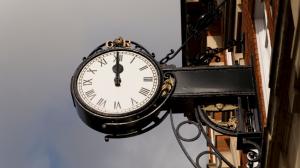
Best Comet of 2025?
C/2024 G3 (ATLAS) has already become very faintly visible to the naked eye for observers in the Southern Hemisphere.
The Day of Our Lady of Africa (Día de Nuestra Señora de África or Fiestas Patronales) is a time of celebration for Christians in the Spanish city of Ceuta, Spain. It is also a local public holiday in Ceuta on August 5.
This is an autonomous community public holiday. Schools, businesses, and government offices in the autonomous communities observing this holiday will be closed.

Flowers are often placed in front of the statue of Our Lady of Africa.
©iStockphoto.com/Angel Herrero de Frutos
The annual fair in Ceuta begins at the end of July and lasts until August 5. Many people visit the fair, especially on August 4 and 5. Many Christians go to the Plaza de África in Ceuta on August 4. They lay flowers in front of the statue of the Our Lady of Africa or outside the church that houses this statue.
On August 5, a group of men known as costaleros carry the statue in a procession through the streets of Ceuta. During the procession, people throw flowers from balconies onto the statue. Fireworks are set off to mark the end of the fair and holiday.
The Day of Our Lady of Africa is a public holiday in Ceuta on August 5, but not in the rest of Spain. Many businesses and other organizations are closed in Ceuta. Many stores are closed but some bakers and food stores may be open. Public transport services may run to a reduced schedule. Parades and the annual Ceuta fair may cause disruption to traffic, especially in the city center.
The Strait of Gibraltar is the narrow sea passage between Spain and Morocco. It marks the point where the Mediterranean meets the Atlantic Ocean. This strait has played an important role in travel networks and the spread of religions for many thousands of years.
Tariq ibn Ziyad conquered the rock of Gibraltar in 711 CE. This marked the start of Moorish rule on the Iberian peninsula. Tariq ibn Ziyad built a mosque on the southernmost point of Gibraltar. Ferdinand IV of Castile captured Gibraltar in 1309 CE. He put a statue of Mary, Mother of Christ, in the mosque and dedicated it to Our Lady of Europe. It is now known as "Our Lady of Europe as Patroness of Gibraltar".
King John I of Portugal and his troops attacked Ceuta on August 14, 1415. He arranged that a Catholic shrine was built in the city. The shrine was dedicated to Our Lady of Africa. The shrines to Our Lady of Europe and Our Lady of Africa flank the eastern entrance to the Strait of Gibraltar. Together, they were important symbols for Christian mariners leaving the sheltered waters of the Mediterranean and entering the rougher seas of the Atlantic Ocean.
A statue of Mary and Jesus known as "Our Lady of Africa" plays an important role in the celebrations. The statue was brought to Ceuta from Lisbon, Portugal, by Henry the Navigator of Portugal. He did this shortly after his father, King John I of Portugal, conquered Ceuta in 1415.
| Year | Weekday | Date | Name | Holiday Type | Area |
|---|---|---|---|---|---|
| 2020 | 水曜日 | 8月5日 (水) | The Day of Our Lady of Africa | Observance | Ceuta |
| 2021 | 木曜日 | 8月5日 (木) | The Day of Our Lady of Africa | Autonomous Community Holiday | Ceuta |
| 2022 | 金曜日 | 8月5日 (金) | The Day of Our Lady of Africa | Autonomous Community Holiday | Ceuta |
| 2023 | 土曜日 | 8月5日 (土) | The Day of Our Lady of Africa | Autonomous Community Holiday | Ceuta |
| 2024 | 月曜日 | 8月5日 (月) | The Day of Our Lady of Africa | Autonomous Community Holiday | Ceuta |
| 2025 | 火曜日 | 8月5日 (火) | The Day of Our Lady of Africa | Autonomous Community Holiday | Ceuta |
| 2026 | 水曜日 | 8月5日 (水) | The Day of Our Lady of Africa | Autonomous Community Holiday | Ceuta |
| 2027 | 木曜日 | 8月5日 (木) | The Day of Our Lady of Africa | Autonomous Community Holiday | Ceuta |
| 2028 | 土曜日 | 8月5日 (土) | The Day of Our Lady of Africa | Autonomous Community Holiday | Ceuta |
| 2029 | 日曜日 | 8月5日 (日) | The Day of Our Lady of Africa | Autonomous Community Holiday | Ceuta |
| 2029 | 月曜日 | 8月6日 (月) | The Day of Our Lady of Africa observed | Autonomous Community Holiday | Ceuta |
| 2030 | 月曜日 | 8月5日 (月) | The Day of Our Lady of Africa | Autonomous Community Holiday | Ceuta |
While we diligently research and update our holiday dates, some of the information in the table above may be preliminary. If you find an error, please let us know.

C/2024 G3 (ATLAS) has already become very faintly visible to the naked eye for observers in the Southern Hemisphere.

How does the 12-hour clock system work? Is midnight 12 am or 12 pm?

February 14 is Valentine's Day or Saint Valentine's Feast. The day of love owes its origins to ancient Roman and European Christian traditions.

Why do many countries set the clocks back and forth an hour twice a year?